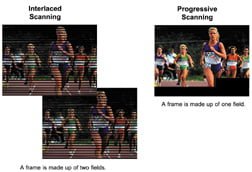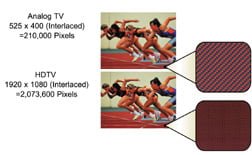What is Digital Television or DTV?
Digital TVs are televisions that can receive and display digital television broadcasts sent using any one of eighteen digital signaling methods. Consumer Electronics Association (CEA) classifies digital televisions in three broad categories: HDTV (High Definition TV), EDTV (Enhanced Digital TV), and SDTV (Standard Definition TV).
How is my current television different from DTVs?
The TV you watch today is based on an analog system developed over 50 years ago. Due to the analog nature of the system, it is likely that your current TV was designed to receive analog signals only. You can receive and display digital broadcasts on your existing analog TV through a digital-to-analog converter box; however, its quality is compromised by the display limitations of the analog TV.
What is the difference between HDTV, EDTV, and SDTV?
HDTV, EDTV, and SDTV reference the ability of a digital television to re-display various digital TV broadcasts in its original format. Digital TV broadcasts can be transmitted using any one of eighteen resolution-formats (See#4); however, digital televisions differ in their ability to redisplay the image, especially when a high-definition image is received.
HDTVs can receive all 18 formats and re-display high-definition images using 540 lines (1080 lines interlaced) or 720 lines (progressive scanning method) without down converting.
EDTVs can receive all 18 formats including high-definition broadcasts and all 18 formats are re-displayed at 480 lines using progressive scan method. This method reduces flicker; however, picture quality may not necessarily outperform 480 interlaced when viewed at normal viewing distances.
SDTVs can receive all 18 formats including high-definition broadcasts and all 18 formats are re-displayed at 480 lines using interlacing (same resolution as current analog TVs). This means that high-definition broadcasts are down-converted in order to display the image at 480 lines.
What are the 18 formats of ATSC standard?
There are 18 digital television formats prescribed by the Advanced Televisions Systems Committee. Six are considered HDTV formats (1080p, 1080i, and 720p). Each format has a different combination of screen resolution, scan mode, frame rate, and aspect ratio requirements.
Vertical Scan Lines
Vertical scan lines refer to the number of horizontal lines a television can display to create an image. As the number of lines increase, more information is displayed, resulting in better picture quality. Traditional analog TVs can display approximately 480 lines, while high-definition television can display up to 1080 lines.
Horizontal Pixels
Each horizontal line in a TV is made up of individual dots (pixels). The higher the number of pixels, the finer the TV picture becomes. Horizontal pixel measurements using today’s technology can range from 250 for a VCR to as much as 500 for a DVD player. Typical digital TV broadcasts have at least 640 pixels.
Aspect Ratio
Aspect ratio identifies the ratio of the TV screen’s width over its height. A 16:9 aspect ratio refers to a wide-screen picture format, while a 4:3 refers to a standard TV format.
Scan Mode
Interlaced scanning is a method that creates a TV picture with alternating lines of information and is the cause for flickering. Progressive scanning is a method that creates a TV picture with consecutive lines of information that results in flicker-free picture quality.
Frame Rate
Motion picture on your TV is generated by a series of still pictures that changes from picture to picture at a very fast rate. This rate is measured by the number of still pictures (frames) displayed within one second of time. The higher the frame-rate, the smoother the picture displayed.
What are the different display technologies used in Digital Televisions?
Digital televisions use the same display technologies available today for analog TVs and computer monitors. They include CRT (Cathode Ray Tubes), LCD (Liquid Crystal Displays), front and rear projection, and PDP (Plasma Display Panels). Most digital TVs today use CRT and projection technologies; however, the CRT maintains an advantage over projection technologies with a wider viewing angle that makes it more suitable for living room viewing.
How is a HDTV/EDTV/SDTV different from a HDTV/EDTV/SDTV Monitor?
In order to receive digital broadcasts, a digital decoder must be used to receive and decode digital broadcast signals. Digital decoders can be built into the digital television itself or they may come in the form of a set-top box that is added separately to the television. HDTV/EDTV/SDTV Monitors are digital televisions without a digital decoder built into the television. HDTV/EDTV/SDTV Monitors give you the flexibility to add a digital decoder in the future when digital broadcasts are more prevalent.
What are the benefits of a Digital Television?
The primary benefits of digital televisions are superior picture quality and better sound. The analog TV signals we watch today are made of 525 interlaced lines and are subject to screen flickering, ghost-shadows, and blurring. Digital televisions are dramatically different in that they receive signals digitally in the form of 0s and 1s so problems with ghost-shadows and blurring go away. Digital signals also produce a higher quality TV picture, displaying crisp, sharp and vivid images using up to 1080 lines instead of 525 lines. Additionally, digital television signals can deliver cinema-quality sound effects using 6-channel Dolby Digital surround sound instead of only two regular stereo channels.
Are digital broadcasts available now?
Digital broadcasts are available through terrestrial (antenna), satellite, and in the near future, cable systems. Major television networks such as ABC, NBC, CBS, Fox, and HBO have already begun broadcasting digital TV programming.
Do I need component inputs or RGB inputs for my DTV?
RGB inputs and component inputs are the best connectivity interface for use with todays high-resolution digital sources such as DVD players (standard or progressive) and HDTV decoder set-top boxes. RGB and component inputs work with video signals that are split into its base components, resulting in a cleaner and purer video signal than all other connection options. There are two types of component inputs and Sampo HDTV Monitors/TVs are equipped with both. The standard component inputs can accept 480i signals while the high-definition component inputs can handle 480i, 480p, 720p, and 1080i signals from progressive DVD players and HDTV decoder set-top boxes.
Can I connect a DTV to my PC or Laptop?
Yes, as long as the digital television is equipped with an RGB input (15-pin D-sub connector). A digital television is essentially a high quality computer monitor capable of displaying various resolutions from today’s advanced video cards. All Sampo HDTV Monitors/TVs are equipped with an RGB-output that lets you connect multiple monitors in series for multimedia presentation purposes.
What does “down-convert” mean?
Down-convert takes place when a digital broadcast signal exceeds the display capabilities of the digital television and the broadcast signal is reduced to match the television’s limited display capabilities. For example, if NBC broadcasts a digital program using 1080 lines (1080i format) while the digital television is only able to display 480 lines (480i or 480p), the 1080i signal is reduced or down-converted to only 480 lines, resulting in inferior picture quality. Sampo HDTV Monitors/TVs can display all digital resolutions from 480 lines to high-definition 1080 lines, eliminating the need for the HDTV decoder to down-convert broadcast signals.
What does “up-convert” mean?
Up-convert takes place when a digital television’s display capabilities exceed the digital broadcast signal and the broadcast signal is increased to match the TV’s display program using 480 lines (480i or 480p) and the digital television is able to display 1080 lines, the signal is increased or up-converted to match the TV, resulting in hazy picture quality. Sampo HDTV Monitors/TVs can display all digital resolutions from 480 lines to high-definition 1080 lines, eliminating the need for the HDTV decoder to up-convert broadcast signals.
Are digital televisions compatible with my existing video equipment?
Most digital televisions are compatible with your existing video equipment; however, this depends on the types of connectivity options available on the digital TV. All Sampo HDTV Monitors/TVs are equipped with multiple connection options for connections with your existing video equipment including VCRs, DVD players, Progressive DVD players, LaserDisc/VideoCD Players, analog and digital camcorders, Digital VHS players, and video game machines.
What will the future of digital television look like?
The broad bandwidth of the new digital television system facilitates a whole new spectrum of programming and data services for your home. For example, this bandwidth allows at least 4 standard-definition TV broadcasts to simultaneously display on your digital TV screen, in addition to displaying data content such as news, stock reports, email, and other data related services. In the near future, your digital television will become an information resource hosting multiple broadcasts in multiple windows while displaying data content in banner strips.



